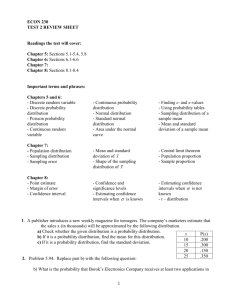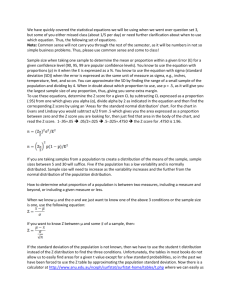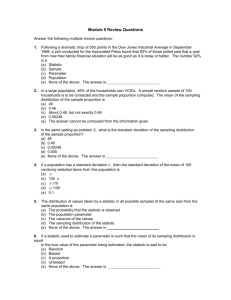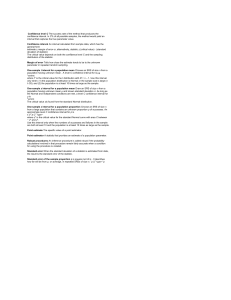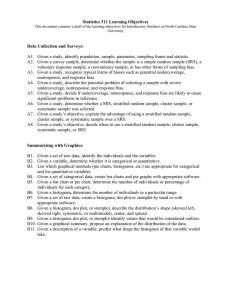Ch. 9 & 10 MC - AHS
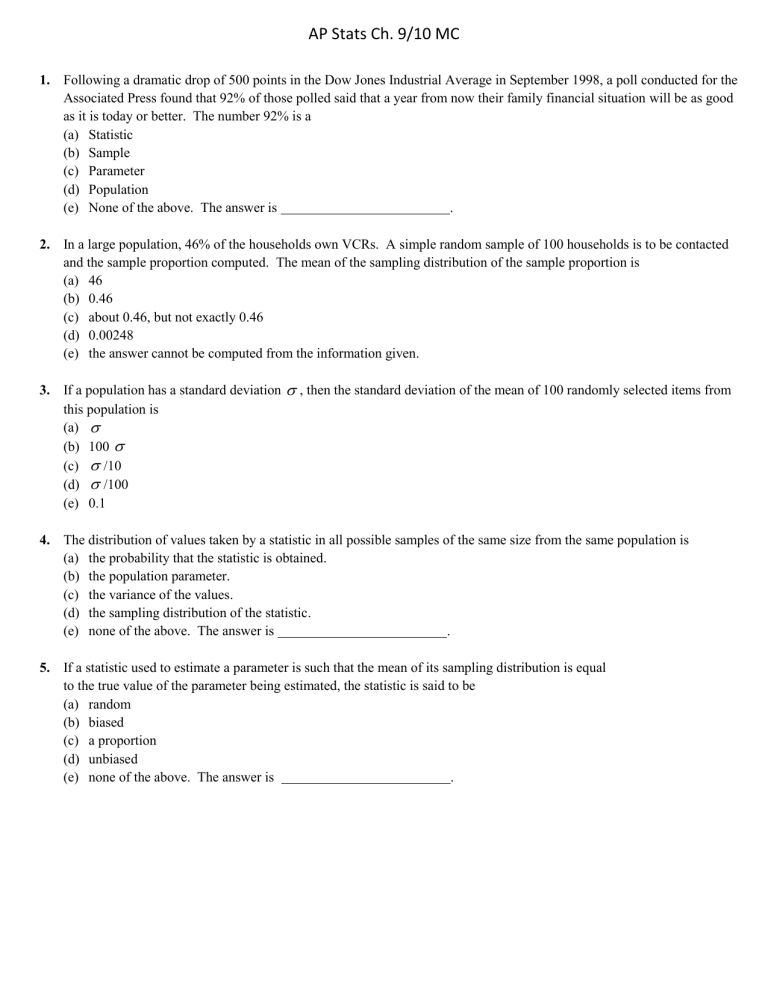
AP Stats Ch. 9/10 MC
1.
Following a dramatic drop of 500 points in the Dow Jones Industrial Average in September 1998, a poll conducted for the
Associated Press found that 92% of those polled said that a year from now their family financial situation will be as good as it is today or better. The number 92% is a
(a) Statistic
(b) Sample
(c) Parameter
(d) Population
(e) None of the above. The answer is .
2.
In a large population, 46% of the households own VCRs. A simple random sample of 100 households is to be contacted and the sample proportion computed. The mean of the sampling distribution of the sample proportion is
(a) 46
(b) 0.46
(c) about 0.46, but not exactly 0.46
(d) 0.00248
(e) the answer cannot be computed from the information given.
3.
If a population has a standard deviation
, then the standard deviation of the mean of 100 randomly selected items from this population is
(a)
(b) 100
(c)
(d)
/10
/100
(e) 0.1
4.
The distribution of values taken by a statistic in all possible samples of the same size from the same population is
(a) the probability that the statistic is obtained.
(b) the population parameter.
(c) the variance of the values.
(d) the sampling distribution of the statistic.
(e) none of the above. The answer is .
5.
If a statistic used to estimate a parameter is such that the mean of its sampling distribution is equal to the true value of the parameter being estimated, the statistic is said to be
(a) random
(b) biased
(c) a proportion
(d) unbiased
(e) none of the above. The answer is .
6.
A simple random sample of 1000 Americans found that 61% were satisfied with the service provided by the dealer from which they bought their car. A simple random sample of 1000 Canadians found that 58% were satisfied with the service provided by the dealer from which they bought their car. The sampling variability associated with these statistics is
(a) exactly the same.
(b) smaller for the sample of Canadians because the population of Canada is smaller than that of the United States, hence the sample is a larger proportion of the population.
(c) smaller for the sample of Canadians because the percent satisfied was smaller than that for the Americans.
(d) larger for the Canadians because Canadian citizens are more widely dispersed throughout the country than in the
United States, hence they have more variable views.
(e) about the same.
7.
The central limit theorem is important in statistics because it allows us to use the Normal distribution to make inferences concerning the population mean:
(a) provided that the sample size is reasonably large (for any population).
(b) provided that the population is Normally distributed and the sample size is reasonably large.
(c) provided that the population is Normally distributed (for any sample size).
(d) provided that the population is Normally distributed and the population variance is known (for any sample size).
(e) provided that the population size is reasonably large (whether the population distribution is known or not).
8.
In a large population, 46% of the households own VCRs. A simple random sample of 100 households is to be contacted and the sample proportion computed. What is the standard deviation of the sampling distribution of the sample proportion?
(a) 46
(b) 0.46
(c) 0.00248
(d) 0.005
(e) None of the above. The answer is .
9.
In a large population of adults, the mean IQ is 112 with a standard deviation of 20. Suppose 200 adults are randomly selected for a market research campaign. The distribution of the sample mean IQ is
(a) exactly Normal, mean 112, standard deviation 20.
(b) approximately Normal, mean 112, standard deviation 0.1.
(c) approximately Normal, mean 112, standard deviation 1.414.
(d) approximately Normal, mean 112, standard deviation 20.
(e) exactly Normal, mean 112, standard deviation 1.414.
10.
You want to compute a 96% confidence interval for a population mean. Assume that the population standard deviation is known to be 10 and the sample size is 50. The critical value to be used in this calculation is
(a) 1.960
(b) 1.645
(c) 1.7507
(d) 2.0537
(e) None of the above. The answer is .
11.
You have measured the systolic blood pressure of a random sample of 25 employees of a company located near you. A 95% confidence interval for the mean systolic blood pressure for the employees of this company is (122, 138). Which of the following statements gives a valid interpretation of this interval?
(a) Ninety-five percent of the sample of employees have a systolic blood pressure between 122 and 138.
(b) Ninety-five percent of the population of employees have a systolic blood pressure between 122 and 138.
(c) If the procedure were repeated many times, 95% of the resulting confidence intervals would contain the population mean systolic blood pressure.
(d) The probability that the population mean blood pressure is between 122 and 138 is 0.95.
(e) If the procedure were repeated many times, 95% of the sample means would be between 122 and 138.
(f) None of the above. The answer is .
12.
An analyst, using a random sample of n = 500 families, obtained a 90% confidence interval for mean monthly family income for a large population: ($600, $800). If the analyst had used a 99% confidence level instead, the confidence interval would be:
(a) Narrower and would involve a larger risk of being incorrect
(b) Wider and would involve a smaller risk of being incorrect
(c) Narrower and would involve a smaller risk of being incorrect
(d) Wider and would involve a larger risk of being incorrect
(e) Wider but it cannot be determined whether the risk of being incorrect would be larger or smaller
13. In an opinion poll, 25% of a random sample of 200 people said that they were strongly opposed to having a state lottery. The standard error of the sample proportion is approximately
(a) 0.03
(b) 0.25
(c) 0.0094
(d) 6.12
(e) 0.06
(f) None of the above. The answer is _____________________________.
14.
You want to compute a 90% confidence interval for the mean of a population with unknown population standard deviation. The sample size is 30. The value of t* you would use for this interval is
(a) 1.96
(b) 1.645
(c) 1.699
(d) 0.90
(e) 1.311
(f) None of the above
15.
A radio talk show host with a large audience is interested in the proportion p of adults in his listening area who think the drinking age should be lowered to eighteen. To find this out he poses the following question to his listeners. “Do you think that the drinking age should be reduced to eighteen in light of the fact that eighteen-year-olds are eligible for military service?” He asks listeners to phone in and vote “Yes” if they agree the drinking age should be lowered and “No” if not. Of the 100 people who phoned in, 70 answered
“Yes.” Which of the following conditions for inference about a proportion using a confidence interval are violated?
(a) The data are an SRS from the population of interest.
(b) The population is at least 10 times as large as the sample.
(c) n is so large that both the count of successes np and the count of failures n (1 – p ) are 10 or more.
(d) There appear to be no violations.
(e) More than one condition is violated.


